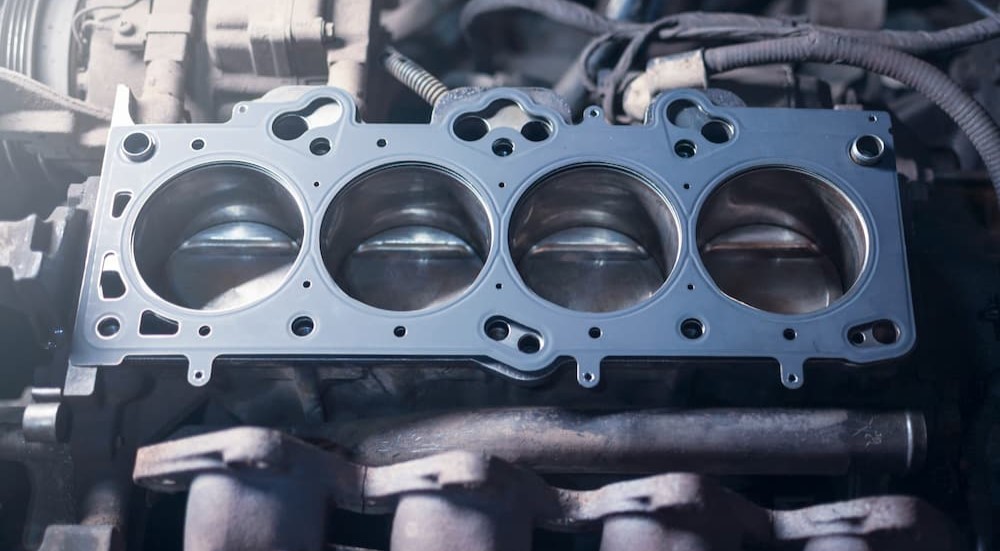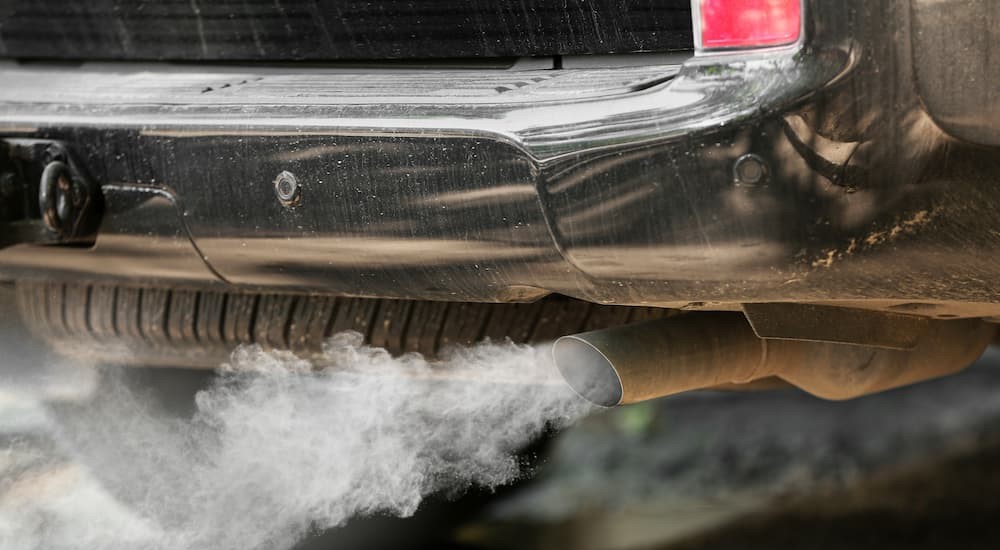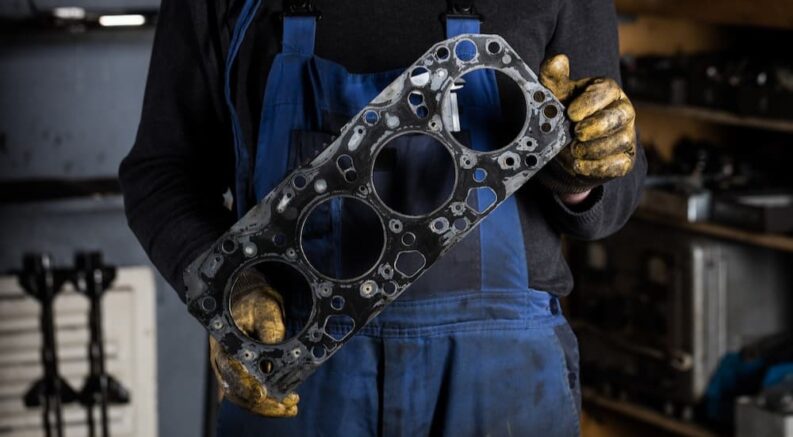The head gasket isn’t the only gasket you’ll find under the hood of your car, truck, or SUV, but it’s definitely the most important. This simple-looking part is responsible for sealing the space between your engine block and cylinder head, and it plays a major role in your vehicle’s safe, effective operation. Head gaskets are designed to last for a long time, but when they do fail prematurely, they’re not an issue that can be ignored. A blown head gasket can quickly ruin an engine, turning your vehicle’s most important and expensive components into worthless hunks of metal in surprisingly short order.
A blown head gasket is most often the result of an overheated engine. When your coolant level is low due to a leak or overlooked maintenance, it can cause an engine’s temperature to stray into the red zone quickly. An overheating engine can also be caused by a broken thermostat, cooling fan, or even some sort of blockage that prevents coolant from cycling through the engine. In some cases, a head gasket repair might not even be a worthwhile investment. If your vehicle is already on its last legs, there’s no reason to sink a couple of thousand dollars into a new head gasket. What does a head gasket do, what are the signs yours needs replacement, and is this even the type of a project a DIY mechanic should undertake? We’ll answer those questions and more in our guide to head gasket replacement.
What Does a Head Gasket Do?
Before we get into some of the finer points of head gasket replacement, let’s take a moment to discuss what this crucial component actually does. Sandwiched between the cylinder head and the engine block, the head gasket is essentially a sort of heavy-duty seal that’s typically composed of multiple layers of steel (though some are made of graphite, copper, or composite materials) and an elastic polymer that has been coated in a rubbery material. This gasket plays a pivotal role in containing the high pressure and temperatures that come with the internal combustion process, thus allowing the engine to reach the proper compression ratio that it needs to work its best. The head gasket also lets oil and coolant flow throughout the engine without leaking or contaminating the cylinders.
In order to understand the importance of the head gasket, try to imagine an engine where the cylinder head and the engine block are bolted directly to one another. This metal-on-metal contact would not provide an adequate seal. It would allow oil to escape the engine and could compromise the cylinder’s ability to create the proper compression ratio. The head gasket does what all gaskets do, filling the space between two hard surfaces to prevent unwanted leakage. Once you understand how a head gasket works, it’s easy to see why this seemingly simple part plays such an important role in a vehicle’s operation.

Should You Replace Your Own Head Gasket?
We won’t bury the lede here. The answer is probably no. We’re generally fans of the DIY approach here at CheckEngine, and believe that the average at-home mechanic can actually perform far more repair and maintenance tasks than they might think, but head gasket repair is not one of them. We’re not trying to gatekeep engine repair, or drive sales for your local auto shop, but chances are that if you found this article by performing an internet search along the lines of “can I replace my head gasket at home,” you’re already well out of your depth. There’s nothing wrong with outsourcing a project like head gasket replacement to the professionals, especially when you consider the potential consequences of an amateur attempt. Your head gasket plays a vital role in containing the explosive force of your internal combustion engine, and even a small mistake can result in a catastrophic failure that can spell the end for your engine.
In truth, replacing a blown head gasket isn’t that difficult, but it’s everything leading up to actual replacement that tends to put this task well outside the comfort zone of the typical DIY-er. In order to access the head gasket, you’ll need to remove no less than a half-dozen components from under the hood including the battery, air intake, intake manifold, hoses, wires, the exhaust manifold, engine-driven accessories, timing cover, and finally, the cylinder head. If this list hasn’t put you off the project, consider that even qualified mechanics can spend between five and eight hours, or even multiple days, if the cylinder head and engine block are in need of a little TLC to remove rust and debris, or if it needs to be smoothed out to ensure a snug fit for the new head gasket.
The project also requires no shortage of specialized tools and supplies, from a torque wrench and cam tools to a head gasket set, head gasket sealant, and more. Most experts also recommended fully replacing the hoses and timing belt or chain while you’re at it, as well as swapping out the valve cover gasket, flushing the coolant system, and installing a new set of spark plugs. Chances are that if your head gasket died of natural causes, there’s plenty of other work that needs to be addressed at the same time. When you take all these related tasks into consideration, it’ll soon become clear that head gasket repair isn’t one project, it’s four or five interconnected projects that have the potential to easily overwhelm even the most ambitious DIY mechanic.
Finally, consider that if your head gasket has failed, the engine may already be damaged beyond repair. It would be terrible to spend all the time, money, and effort into replacing your head gasket yourself, only to find that the engine won’t even start or run afterward. That’s why it’s best to take your car to a mechanic familiar with these types of issues, who can help you decide whether it’s best to replace the head gasket or the entire engine.
Signs of Bad Head Gasket
Given that it’s commonly referred to as a “blown” head gasket, you would think that the signs of failure would be pretty obvious. Fortunately (or unfortunately, depending on how you look at it) that’s not usually the case. As long as your bolts are still firmly attached, a blown head gasket isn’t going to result in a sudden explosion, but there are usually some clear signs that something has gone amiss. These signs might manifest in different ways, but they usually all boil down to one common issue: oil and coolant making their way to places where they’re not supposed to be. Lets review these common signs of head gasket failure and give you a better idea of what sort of symptoms to look out for.
Overheating: When exhaust gasses make their way into the cooling system, or coolant leaks into the engine, an overheated engine usually isn’t far behind. Keep an eye on your engine temperature gauge and immediately stop driving if you notice that you’re entering the danger zone. An overheated engine can cause all sorts of problems, including a warped cylinder head or damage to the catalytic converter.
Discolored Oil or Coolant: In a perfect world, oil and coolant should never mix, but that can all change when you’re dealing with a blown head gasket. As coolant makes its way into the oil, it’ll often result in discolored oil that looks almost milky. If, on the other hand, you notice that the liquid in your radiator’s coolant reservoir is looking darker than usual, it could indicate that a little oil has started to mix in with the antifreeze.
White or Blue Smoke: When your car starts sending smoke signals, it’s important to pay attention. If a blown head gasket is causing coolant to leak into the cylinder, it’ll produce white, sweet-smelling smoke from the tailpipe. It’s also possible to spot blue smoke caused by oil leaking into the cylinders, but this is generally less common.
Performance Issues: When an engine isn’t able to produce the proper compression, it usually manifests as a loss of power and an engine that runs a little rougher than normal. This sort of failure often produces a distinctive leaking noise and a knocking sound that can be heard from inside the cabin.
Bubbles in the Radiator: If the coolant inside your radiator or coolant reservoir is bubbly, you might have a blown head gasket. These bubbles are caused by exhaust gasses escaping into the vehicle’s cooling system.

Alternatives To Replacement
If DIY head gasket repair is a little too intimidating and the professional approach is outside of your price range, there is a potential alternative. In some cases, a bottle of head gasket sealer can help breathe a little life into a compromised head gasket. Typically added to a vehicle’s cooling system, a 16-ounce bottle of something like BlueDevil Pour-N-Go Head Gasket Sealer is an affordable alternative to the $1,200 to $2,200 a qualified mechanic might charge for a full head gasket repair.
There are some limits to these stop leak products. If the engine can’t run for 15 minutes without overheating, chances are you’re past the point where a $40 bottle of stop leak additive is going to fix the problem. While they might work wonders for a busted head gasket that’s leaking gasses into the cooling system, stop leak products can’t prevent coolant from making its way into the engine oil or vice versa. Stop leak products are also less effective on some specific engines and aren’t really an option if the cylinder head has warped or separated from the engine block. It’s also important to keep a close eye on your engine after using any such product. If you still notice any of the common signs of a compromised head gasket after using a stop leak product, it’s probably best to call in the pros rather than doubling down with a second treatment.
The phrase “head gasket replacement” has been known to strike fear into the heart of even the most wizened mechanic. The labor involved in simply accessing the head gasket can easily eat up half a working day, and there’s no telling how far gone the surface of the engine block and cylinder head might be until you’ve already sunk a few hours into the project. For these reasons and a whole lot more, head gasket repair is one project you should probably not attempt to undertake from the comfort of your own garage. There are simply too many things that can go wrong, from improper head gasket replacement to bolts not being tightened down correctly, not to mention all the associated components and systems that are attached to the engine itself. You can’t skimp on head gasket repair, and while a simple bottle of stop leak additive might fix a milder case of head gasket-itis, sooner or later you’ll probably need to swallow your pride and make an appointment with a trusted local mechanic or dealership.

